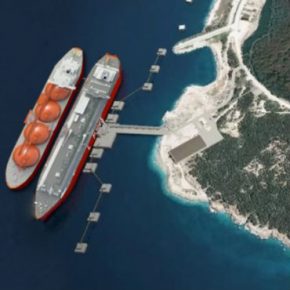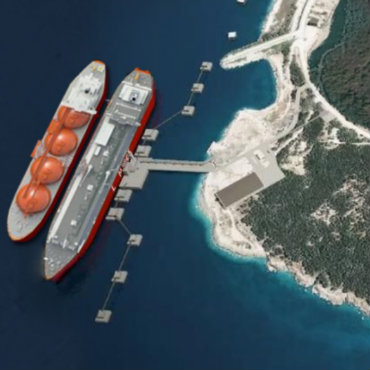Tydzień w gospodarce
Category: Trendy gospodarcze
Analyst, journalist specializing in the Western Balkans and Middle East domestic and foreign affairs

(LNG Croatia LLC, Public domain)
Some consider it a United States-sponsored project as an economic buffer-zone between Germany, Russia, and Turkey. Others believe it is solely a success of Polish-Croatian diplomacy and a result of their good connections in Washington, or a solely Polish initiative that carries much threat to the CEE countries. Whatever it might be, economically the Initiative tends to connect Adriatic, Baltic, and Black Seas into a sustainable infrastructure and energy zone, depending on LNG terminals that are going to be built in Poland and Croatia.
Croatia plans to build a floating LNG terminal on the northern coast of the island of Krk. And although the project is in process of making for over a decade now, there are still lots of questions whether the LNG terminal is indeed necessary for the Croatian and European market. Strategically, it may be of importance, but even if it is completely funded by the EU, it should have a financial sustainability by itself (read more).
EU is especially interested in the LNG floating terminal in Croatia and is ready to guarantee up to EUR315bn for investments in the private sector (the so-called Juncker Plan). Of EUR168bn in last 1.5 years, one-quarter is used in the energy sector. But Juncker’s plan is often criticized as being helpful only to the large and rich member states. This is a fact, but smaller projects in smaller states couldn’t be done without this instrument either. The disappointment of the smaller states partially led to the Three Seas Initiative, especially after Germany and Russia sealed the agreement for North Stream II.
Croatian government was ready to enter with a maximum of 25 per cent of shares into the Krk LNG project. In the end, the Coordination Committee of the Connecting Europe Facility, one of the EU funding instruments that promote growth, jobs and competitiveness through targeted infrastructure investment, has decided to co-finance the building of LNG terminal with EUR102m. Out of these, 50 per cent is given for the drafting and adopting various studies, while 27,94 per cent for the engineering itself. It is a first step to gain other project funds.
Estimated costs of the project are EUR363m and the start of the construction is expected in 2019. Given the fact it will be a floating terminal, which means that tankers are going to be tied to the coastline, where already an oil terminal exists, this plan sounds realistic enough. But, Croatian agencies are skeptical if this terminal has any logic at all.
The process of the construction includes the connection pipelines from Krk to the major pipelines in Croatia and interconnection with Slovenia and Hungary. If necessary, the plan contains connections with other states, such as Serbia and Bosnia and Herzegovina. This necessity is going to be determined by the market, as the demand will tell what transport capacities are needed.
Estimations point to some five billion cubic meters (bcm) of LNG gas, which calls for an investment of EUR300m. However, current capacities of transport stop at some 1.7 bcm of gas, while the first phase of construction on Krk island should plan at least 2 bcm. The decision will be made according to the supply-demand ratio in the next short-term period. Russia currently exports over 170 bmc of gas annually. By 2018 the transport over Ukraine will be closed and North Stream I will be a primary focus of Russian gas exports. Potential customers, however, point they will buy the gas that is going to be cheapest.
The project is conducted by the LNG Croatia, a company under the auspices of government-led Plinacro gas operator and transportation service provider in Croatia. It is now headed by Goran Frančić, after the government reshuffle released former director Mladen Antunović. Both, however, strongly believe that gas will replace oil as the biggest energy item on the global market, especially after Qatar, Algeria, United States, and Australia joined as the global gas suppliers.
This contributes to the source diversification, but also raises the costs of gas. Regional governments are not talking about the price of gas the Central European nations will have to pay, comparing to the politically undesired but economically cheaper Russian gas. There are lots of discussions in public over these costs and certainly lots of lobbying in media, but the bottom line is that LNG and pipelines cannot be easily compared. At the same time, pipelines themselves carry the higher price if they pass through the urban areas.
Croatia should act quickly, as Krk terminal is not the only one option on the table. Scandinavian and the Black Sea approaches are the biggest challenges to Croatian efforts and slow administration is a major problem in the decision-making process. Croatian president Mrs Kolinda Grabar-Kitarović tried to boost the process while visiting Qatar in April this year, where she talked about the implementation of the LNG terminal project with the Qatari Sheikh Tamim bin Hamad bin Khalifa al-Thani. Qatari and Iranian gas (both countries share the world’s largest gas field South Pars, in the Islamic Republic of Iran) is intended to be the major source in Krk terminal. But, the current crisis in the Persian Gulf poses serious questions how reliable such a flow can be.
The question of construction profitability is closely related to the global reach, as the countries of former Yugoslavia have together a demand for up to 6 bcm annually, and still vast areas of the Balkans do not have gas networks, including the nearby Istrian Peninsula, which is the major Croatian tourist spot. Other important additions are prices and the role of the gas geopolitics. The Russian factor is unavoidable, as Russia will continue to be the major source of European gas demand.
As an answer to an „undesirable“ Russian gas, European Union members, especially Germany, Benelux and Scandinavian countries, try to introduce as many renewable resources as possible and thus decrease the oil&gas consumption. The same decrease is seen in the Balkan countries (read more about Serbian green energy and Albanian), but rather because of environmental care, it is because of recession and economic depression, and not because they have experienced the energy reconstruction.
Southeastern Europe mostly relies upon the transport corridors from Ukraine. Energy and geopolitical consequences of the current crisis in Ukraine and decisions to block this route soon have a potential to destabilize the gas market in the Balkans. After the South Stream was cancelled, Turkish Stream became an important project for the Balkans and especially TAP (Trans-Adriatic Pipeline), which would bring the Azerbaijan gas through the Turkish and Albanian pipelines to Italy, but also includes the adjustment to the Ionian-Adriatic pipeline that can fulfill the demands of Croatia, BiH, and further the Central European states. Most of these countries are vulnerable on the energy imports as their demands have dropped because of the economic recession. Some of them, like Bosnia, Serbia, Romania, and Bulgaria, are especially fragile as their economy is dependent on the energy imports. In the case of minimal flows through Ukraine, their energetic systems might experience severe difficulties and become collateral victims in the geopolitical conflict.
Vedran Obućina is an analyst and a journalist specializing in the Croatian and Middle East domestic and foreign affairs. He is the Secretary of the Society for Mediterranean Studies at the University of Rijeka and a Foreign Affairs Analyst at The Atlantic Post.


